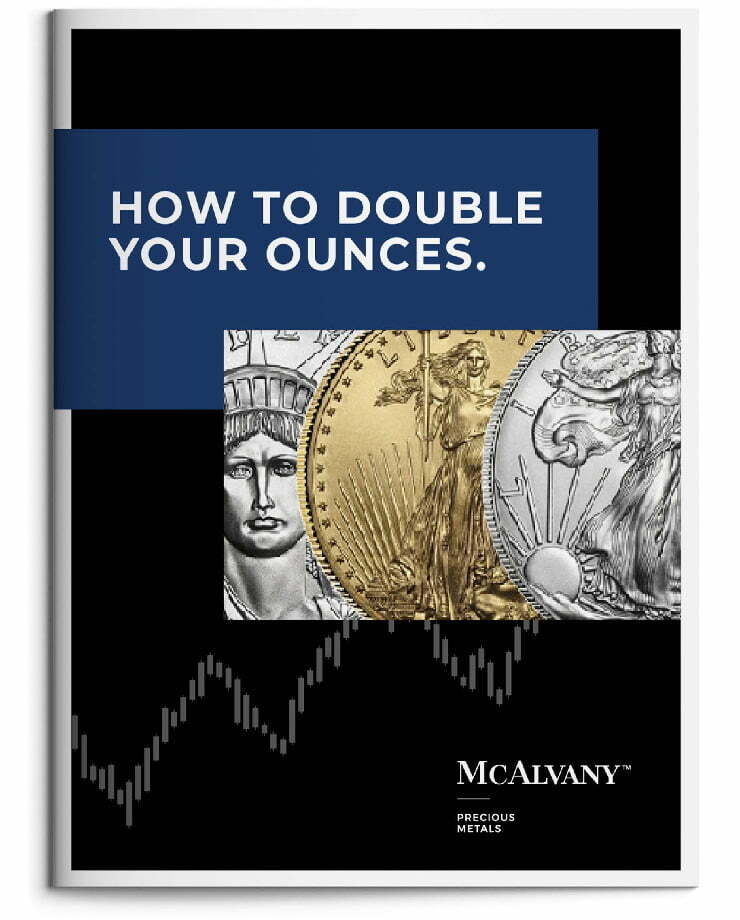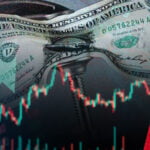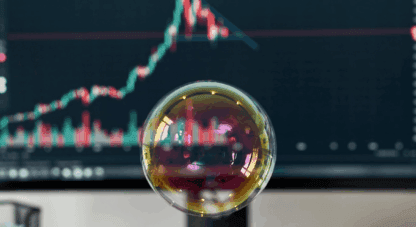Podcast: Play in new window
Historic ‘24 Excess Portends Precarious 2025 – January 30, 2025
David: Good afternoon. This is David McAlvany. We’ll go ahead and get started. This is our January 30th, 2025 Tactical Short conference call titled Historic 2024 Excess Portends Precarious 2025.
Good afternoon. Thank you for participating in our fourth-quarter recap. As always, thank you to our valued account holders. We so greatly value our client relationships. With first-time listeners on today’s call, we’ll begin with some general information. And for those of you unfamiliar with Tactical Short, more detailed information is available at mcalvany.com/wealth/tactical-short/.
If you’d like to explore next steps for opening a Tactical Short account or investigate how the service might complement your existing equity exposures, it’s a good time to do so. The order of our call today will be my comments on performance followed by Doug’s market commentary and then Q&A at the tail end.
I have a number of questions already submitted. You may submit further questions to Ted via his email [email protected]. And also, for inquiries on Tactical Short and its inclusion in your current strategies, you can also submit those inquiries to [email protected].
The objective of Tactical Short is to provide a professionally managed product that reduces the overall risk in a client’s total investment portfolio, while at the same time providing downside protection in a global market backdrop with extraordinary uncertainty and extreme risk. The strategy is designed for separately managed accounts. It’s investor friendly with full transparency, flexibility, reasonable fees, and no lockups.
We have the flexibility to short stocks and ETFs and our plan has been to on occasion buy liquid listed put options. Shorting entails a unique set of risks we’re set apart both by our analytical framework as well as our uncompromising focus on identifying and managing risk.
Our Tactical Short strategy began the quarter with short exposure targeted at 80%. The target was held steady throughout the quarter, focused on the challenging backdrop for managing short exposure. The short in the S&P 500 ETF, SPY remains the default position for this high-risk environment.
I’ll give you an update on performance. Tactical Short accounts after fees returned negative 1.73 during Q4. The S&P 500 returned a positive 2.39. So for the quarter, Tactical Short accounts returned negative 72% of the S&P 500’s positive return. As for one-year performance, Tactical Short after fees returned negative 15.32% versus the 25% return of the S&P, with Tactical Short losing 61.3% of the S&P 500’s positive return.
We regularly track Tactical Short performance versus three actively managed short-fund competitors. First, the Grizzly Short Fund, which returned a negative 1.64 during Q4, and over the past year Grizzly returned a negative 6.74. Ranger Equity Bear returned a negative 5.71 for the quarter, with a negative 7.97 for a one-year return. And Federated Prudent Bear returned a negative 0.68% during Q4 and a negative 12.32 for the one year. Tactical Short outperformed the actively managed bear funds for the quarter on average by 95 basis points.
Tactical Short underperformed over the past year by an average 631 basis points. It has significantly outperformed, Tactical Short has, each of the bear funds since inception. From April 7th, 2017 inception through the end of the year, Tactical Short outperformed each of the three competitors by an average of 1,743 basis points or 17.43 percentage points.
There are also the passive short index products. ProShares’ short S&P 500 ETFs, which returned a negative 70 basis points for the quarter and a negative 13.51% for the past year. And the Rydex Inverse S&P 500 fund, which returned negative 0.53 in Q4, negative 13.08 for the one-year numbers. And then the PIMCO StocksPLUS Short Fund with a Q4 return of negative 15 basis points and a one-year return of negative 11.69. And that’s our performance update.
Doug: Thanks, David. Hello, everyone. Thank you for being with us. It’s been an eventful few months. A pivotal election and red sweep with prospects for deregulation and pro-growth policies dousing additional fuel on highly speculative markets. President Trump’s White House return with a barnstorming number of day-one executive orders and nonstop actions. There was a historic fire in Los Angeles with property damage and economic loss estimates as high as 275 billion with broad ramifications for insurance markets. We live in an age of heightened uncertainty and insecurity along with one heck of an overheated financial sector and speculative bubble.
Let’s begin with comments on performance. As David highlighted, Tactical Short outperformed on average by 95 basis points during Q4, and 17.43 percentage points since inception. It’s worth noting that Tactical Short outperformed during the quarter despite the current competitive disadvantage of not generating a cash return on proceeds from short sales.
I’ve discussed this previously. When a stock is shorted, the sales proceeds go into a restricted account at the brokerage where they’re held until used to unwind the short. The mutual funds have arrangements with their brokers to receive a cash return on these balances. With the Fed cutting rates, this return advantage for them has declined from around 120 basis points a quarter to less than a hundred. Expecting ongoing volatility, I stuck with the wider-than-typical band around short exposure discussed in previous calls.
A wider band provides an advantage in volatile market environments, reducing the amount of buying and selling—the so-called rebalancing—necessary to return exposure to the target. Markets were notably volatile during Q4.
Most of the short mutual funds rebalance daily, meaning holding back stocks to reduce exposure when a rising market pushes short exposure above target or selling shares when a declining market reduces short exposure below target.
Doing this on a repetitive daily basis—buy high, sell low—negatively impacts performance, especially in volatile market environments where daily rebalance trading can regularly exceed 1% of fund assets. The wide band around the short target, our short target, significantly reduced our rebalance rating. The disadvantage of the wider band comes when rallies force short exposure rebalancing at the top of the band, along with a generally to somewhat higher short exposure in a rising market environment.
I would estimate that the performance advantages and disadvantages of the wider band were about a wash during Q4. It’s worth noting that the competitive fund that typically has the most volatile short portfolio of individual company shorts performed dismally during the quarter, with its Q4 loss more than double the S&P 500’s positive return. The Goldman Sachs Most Short Index returned 6.7%, almost triple the S&P 500 return.
Short products which are volatile and with highly variable correlations to the S&P 500 provide less than compelling market hedges. For Tactical Short, our investment philosophy and process dictate a focus on exposure volatility, or beta, as we strive in a most challenging environment to provide a hedging product with relatively predictable correlations to the S&P 500 without big negative surprises. We never anticipated the market would almost triple from Tactical Short’s inception. It’s been grueling, but we haven’t wavered from our process or risk disciplines.
The fourth quarter again showed why we have avoided shorting individual company stocks. Another high-profile short seller, Hindenburg Research, was the latest to end operations. We again kept our powder dry with put option purchases. As tempting as it’s been to bet on market tops and reversals, our focus on financial conditions has demanded discipline. Ongoing loose financial conditions have dictated that we remain in our default position of short exposure only in the S&P 500.
The Federal Reserve reduced rates twice during the quarter. Two days after the election, and again on December 18th. In my almost four decades following Federal Reserve policymaking, the Fed had not previously cut rates with financial conditions so loose. System credit growth remained exceptionally strong, docs traded at record highs, the economy was resilient at 3% growth and historically low 4.1% unemployment, and inflation was stubbornly and meaningfully above the Fed’s 2% target.
Nevertheless, Federal Reserve officials referenced some nebulous neutral rate as they slashed rates a hundred basis points in three months. I struggle how best to put Q4 and 2024 excess into [unclear] historical context. We’ve witnessed the extraordinary for so many years that it has become business as usual. My analytical framework generates maxims, including how things turn crazy at the end of cycles. As noted in past calls, my macro analysis journey began in the ’80s, witnessing market volatility in an ’80s equities bubble, the 1987 stock market crash, Greenspan’s liquidity assurances, and the reemergence of a more systemic bubble in credit to commercial real estate, junk bonds, LBOs, and various Wall Street accidents.
Post bubble, this era was called the decade of greed. Greater Fed reflationary measures stoked the ’90s tech bubble. That ball-turning bubble provoked a stronger reflationary response and a much greater mortgage finance bubble, a more powerful bubble deflation, and the so-called great financial crisis provoked a historic reflationary response from the Bernanke Fed. But that period’s trillion-dollar QE money printing operation was dwarfed by the Powell Fed’s $5 trillion pandemic response.
My fascination was piqued back in the ’90s. I’ve spent more hours studying the Roaring Twenties period than I care to admit. The analytical framework and perspective I’ve developed through my analysis of that most critical period in US history are fundamental to how I view Roaring Twenties 2.0.
A critical debate arose after the Roaring Twenties boom ended with the 1929 crash and Great Depression. The conventional Milton Friedman/Ben Bernanke view materializing decades later holds the Fed directly responsible. More specifically, they target the Fed’s late-decade tightening measures along with their failure to print sufficient money as the boom faltered. Not coincidentally, these days, the Fed stops short of tightening financial conditions while erring on the side of monetary inflation.
I’ve studied enough contemporaneous analysis from the ’20s to take strong exception to the revisionist dogma. It’s certainly comforting to believe that that era’s prosperity—the so-called golden age of capitalism—was sound and sustainable if not for unenlightened policymaking. We don’t hear central bankers, politicians, or even academics these days beckoning for tighter financial conditions necessary to restrain bubble excess.
The key enduring lesson from the original Roaring Twenties period should have been how dangerously bubble inflations evolve over years of easy money and policy neglect. Risks to market, economic, social, and geopolitical stability are much too great to allow credit and speculative excess to run unchecked year after year.
Years ago, I incorporated elements of Austrian economics into my analytical framework. There’s no doubt in my mind that the 1929 crash and Great Depression—with the consequences of a protracted cycle of egregious financial excess; the evolution of a deranged financial apparatus that promoted unprecedented resource misallocation and resulting deep financial and economic structural maladjustment; and leveraged speculation, including broker call loans and highly leveraged investment trusts—was instrumental in years of systemic liquidity overabundance. Monetary disorder stoked self-reinforcing asset inflation and speculative excess, spending distortions, and epic malinvestment.
At this point, there should be little debate. Today’s Roaring Twenties excesses are the most extreme since that fateful a century ago. Critical long-forgotten lessons from America’s worst bubble experience are most germane. Unchecked asset inflation and speculation are pernicious. Spending and investment fueled by liquidity emanating from leveraged speculation are self-reinforcing but unsustainable. Major bubbles create latent fragilities, and bubbles don’t work in reverse. There is really no cure other than to ensure bubbles aren’t allowed to inflate indefinitely.
And something else pertinent from my study of that period. Manias are incredibly insidious and powerful. An astonishingly few in 1929 recognized how fragile the system had become late in the cycle with speculators, investors, economists, Wall Street, bankers, central bankers, and government officials all captivated by markets in the throes of manic excess.
The two Roaring Twenties share key dynamics. Both were extraordinarily protracted cycles characterized by rapid credit growth, prolonged speculative asset bubbles, far-reaching deviations in investment spending, and momentous technological and financial innovation. I’ll add that historic bubble inflation has a prerequisite. The environment and prospects must appear exceptionally bright, demonstrably promising. Indeed, phenomenal technological innovation and development, along with deep-rooted optimism, are part and parcel to spectacular bubbles.
David and I have done many of these calls. I’ve delved deeply into my analytical framework and thesis. There’s part of my psyche that would almost prefer to say, “Okay, I’m wrong in this History’s Greatest Bubble thesis. Ready to get on with my life.” The problem is, the evidence of bubble excess is unequivocal and turns only more powerful by the quarter. From economic data to market behavior to social, political, and geopolitical dynamics, from all directions come convincing thesis corroboration.
After such a long cycle, everyone is numb. But the key takeaway from this call is that late-cycle excesses lurched to a more extreme, more precarious junction. I’ll share some examples.
Global issuance of corporate bonds and leveraged loans last year surged 30% from 2023’s level to $8 trillion. Total US corporate debt issuance ballooned more than 30% to $1.96 trillion. Companies borrowed $2.22 trillion of risky leveraged loans—more than double 2023’s level. Municipal debt issuance surged 32% to a record of $508 billion. While data is scant, the historic boom in private credit turned increasingly manic. The lack of transparency is an issue for what is essentially lightly regulated risky subprime corporate credit. Too much of it funneled into annuities and other popular retail insurance products.
And the sign of the times from Bloomberg, and I’ll quote, “The world’s 500 richest people got vastly richer in 2024, with Elon Musk, Mark Zuckerberg, and Jensen Huang leading the group of billionaires to a new milestone, a combined 10 trillion net worth. The eight tech titans alone gained more than 600 billion—43% of the 1.5 trillion increase among the 500 richest.” Signs of runaway speculation are everywhere. For a fifth straight year, the Chicago Options Exchange reported record trading volume across its four US options exchanges last year, reaching 3.8 billion contracts.
Here I’ll quote, “Trading in options expiring the same day averaged more than 1.5 million contracts a day in the last three months of 2024, accounting for 51% of the overall S&P 500 index options volume.” Last year saw record trading in interest rate and equity futures contracts.
Another quote, “Trading volume for centralized crypto exchanges hit a record of 11.3 trillion in December. The bitcoin network completed more than 19 trillion in transactions last year, more than doubling 2023. Average daily corporate debt trading surged 21% year over year and it was a record year for Treasury futures trading.” Quoting from the Wall Street Journal, “Investors plowed more than 1 trillion into US-based exchange-traded funds in 2024, shattering the previous record set three years ago. Total assets in US-based ETFs reached a record 10.6 trillion at the end of November. Collapse in risk premiums also evidenced extreme market risk embracement. Investment grade yield spreads versus Treasuries narrowed to as little as 73 basis points in Q4, the lowest level all the way back to March 2005. High-yield spreads narrowed to 253 basis points below since June 2007. High-yield spreads traded last week only three basis points off those lows.”
Money market fund assets or MMFA expanded 873 billion or 14.6% last year. Even more remarkable, MMFA ballooned a blistering 27% pace during the final 22 weeks of the year. A period when the Fed aggressively loosened policy. MMFA expanded an incredible 2.29 trillion, or 50%, since the Fed began tightening in March of ’22, and 3.21 trillion, or 88%, since the start of the pandemic.
This unrelenting historic monetary inflation basically goes unreported, completely overlooked by Wall Street analysts, the economic community, and even the Federal Reserve. I have previously discussed the interplay between the proliferation of levered speculation and growth in money market assets.
The highly-levered Treasury basis trade reportedly surged to a record 1.15 trillion by early November. And I suspect rapid growth has been ongoing. Some of the major hedge funds financed levered Treasury holdings in the repo market, playing the tiny spread between cash bonds and their Treasury futures short positions. This expansion of repo borrowings generates new marketplace liquidity intermediated through the money market fund complex, resulting in an expansion of fund assets.
Examining the data, total system repo assets inflated 678 billion, or 30% annualized, during combined Q2 and Q3 to 7.4 trillion. Broker dealer assets surged 341 billion, or 26% annualized, during Q3 to a record 5.53 trillion, with one-year growth of 16.2%. Here’s a data point with huge ramifications. Repo assets inflated 2.58 trillion, or 54%, over 19 quarters.
Powerful system-wide credit growth is unrelenting. Non-financial debt—that’s NFD from the Fed’s Z1 data—expanded 3.47 trillion over the 12 months ended September 30th. For perspective, NFD expanded 2.5 trillion in 2007, an annual record that held all the way until the pandemic. Treasury issuance continues to dominate system credit growth. At Q3’s end, Treasuries had inflated 1.97 trillion over the previous year, 3.97 trillion over two years, and a reckless 10.96 trillion, or 66%, over the past 19 quarters.
This historic expansion of money and credit is the fuel inflating a once-in-a-century securities bubble. Total debt in equity securities inflated 24.5 trillion, or 19%, over the previous year, and 58.7 trillion, or 62%, over five years to a record 153 trillion. One of my favorite bubble ratios. Total securities ended Q3 at 522% of GDP, dwarfing cycle peaks of 375% from Q3 2007 and 357% during Q1 2000. And to continue this chain of bubble analysis, household net worth—assets less liabilities—inflated 17.2 trillion, or 11.4%, in the 12 months ended September 30th to a record 169 trillion. Net worth inflated 50 trillion over 17 quarters, that’s 42%.
Another illuminating bubble ratio. Household net worth ended September at 575% of GDP, eclipsing previous cycle peaks 488% in Q1 ’07 and 444% during Q1 2000.
This flurry of numbers will have to suffice for egregious ’24 excess. I refer often to the concept of terminal phase excess, and for good reason. Late cycle blow-offs are self-destructive. For one, manic speculative excess is unsustainable. Fragility grows as the crowd pushes the limits of risk embracement, the bounds of exuberance, and leverage. Meanwhile, system stability is compromised by a parabolic rise in systemic risk, with the expansion of ever larger quantities of increasingly risky credit.
The ongoing boom in private credit deserves mention. As an analyst that watched in disbelief as subprime loans and related derivatives ballooned during the mortgage finance bubble’s terminal phase, the current manic fervor throughout subprime corporate credit and leverage lending is even more alarming. For too long, finance has remained readily available for unprofitable and financially suspect companies. As always, high-risk lending appears almost miraculous so long as companies enjoy unending market access to fund operations and to roll over maturing obligations. But when the music stops, the system faces a deluge of negative cash flow enterprises and painful debt and economic crises.
With this subprime corporate debt boom in mind, some thoughts on the historic AI bubble. This really is the embodiment of late cycle overkill, more precisely multi-decade supercycle terminal access. We’re talking about an epic spinning black hole, literally trillions for data centers, computer servers, energy and cooling infrastructure, software development, corporate AI implementation, and so on. And while the impacts of the adoption of artificial intelligence will surely be positive—momentously positive likely—prospects for profits sufficient to justify trillions of expenditures are anything but clear.
History informs us that these kinds of runaway manic speculation borrowing and spending bubbles ensure a legacy of losses, insolvent companies, malinvestment, and deep structural maladjustment. Hundreds of internet companies failed with the collapse of the late ’90s tech bubble. Most internet IPOs from that period filed for bankruptcy. The proliferation of Roaring Twenties-era radio and communications companies suffered a similar fate.
It was a most pivotal election in November. And on the third day of President Trump’s term, he announced an AI joint venture with SoftBank, OpenAI, and Oracle, with a 500 billion investment goal. I imagine Elon Musk and other industry heavyweights will redouble their efforts. Friday, Meta Platforms announced plans for 65 billion of AI-related spending this year, 27% ahead of what analysts had expected, including a new data center, and “so large that it would cover a significant part of Manhattan.”
And then Monday’s markets were rocked by a small Chinese AI startup named DeepSeek and its low-cost and impressive AI tool. Nvidia was slammed 17%, with a 560 billion evaporation of market capitalization, the largest in history. The semiconductor index sank 9%. Suddenly, key aspects of the bullish narrative looked flimsy. Beyond tech, energy and utility stocks which had been rising to the moon abruptly headed back to earth. President Trump called it a wake-up call.
This historic late-cycle global arms race is led by an extremely well-capitalized tech oligarchy, scores of technology operators globally, increasingly by governments desperate not to be left behind, and overheated debt markets enamored by high-yielding credit.
Risks of overheating are rising. An economy that has been expanding at a 3% pace with historically low unemployment will now receive additional stimulus from the tech investment boom, weather catastrophe rebuilding in North Carolina, Florida, California, and elsewhere, and a vigorous Trump 2.0 pro-growth agenda. President Trump is determined to spur an economic boom. With lending and system credit growth already overheated, it’s a delicate juncture in the cycle for aggressive financial and economic deregulation.
10-year Treasury yields at 3.65% the session before the Fed began cutting rates in September, ended the year 92 basis points higher. Importantly, yields today are almost 100 basis points higher in the face of the Fed’s 100 basis points of rate cuts. This is definitely not what Wall Street and the Fed had anticipated, and I believe this unusual move portends bond market struggles ahead. It challenges the view that central bank rate cuts are always available to bolster markets in the event of instability.
Importantly, the surprising yield surge unleashed instability at the vulnerable global periphery. For the quarter, yield spikes included Panama’s 177 basis points, Brazil’s 137, and Mexico’s 99 basis points. Many EM bond yields surged to multi-year highs with currencies also under pressure. Losses for the quarter included 18% for the Russian ruble, 12% for the Brazilian real, and 11% for the South Korean won. For the year, the Argentine peso declined 22%, the Brazilian real and Russian ruble 21%, and the Mexican peso 19%.
UK yields surged 56 basis points during the quarter, and then spiked an additional 32 basis points in early January to 4.89%—the high back to July 2008. Recall that UK gilts, that market suffered a bout of deleveraging back in Autumn ’22. The bond market revolted against new UK Prime Minister Liz Truss’s budget, canceling her term after only 49 days. I draw attention to this event, viewing it as a key juncture for global markets, the reappearance of the long-lost bond vigilantes. Traders taking things into their own hands, drawing a line, and finally imposing discipline on spendthrift governments. We saw during Q4 and early in January discipline beginning to be imposed universally.
There is today elevated risk that the vigilantes turn their sights on US Treasuries. The Fed committed a major error, slashing rates with quite loose financial conditions, economic resilience, and sticky inflation. Core CPI was at 3.2% in December, having declined only a 10th over the previous six months. Expected one year inflation from the University of Michigan’s January survey jumped to 3.3%, matching the high since November of ’23.
The risk of bond market instability is high and rising. The Trump administration could enjoy a bit of a bond market honeymoon, especially if tariff directives are not as forceful and urgent as feared, or if equities falter. Speaker Johnson has announced an aggressive legislative schedule, with plans to pass one big beautiful bill within three months. Congress will extend the Trump tax cuts while lowering the corporate tax rate. The president has reiterated his pledge to exclude tip income from taxation. He also campaigned on eliminating taxes on overtime pay and social security. Discussions are ongoing to boost the state and local tax deduction.
As GOP lawmakers jostle for constituent benefits, the Wall Street Journal ran with the headline, “Tax Cut Wish List Grows for Trump’s Big Beautiful Bill.” And at this point, meaningful cost-cutting is a work in progress. President Trump may move forward on an aggressive tariff regime, using prospective tariff revenues to partially offset new tax cuts. The bond market could take a dim view of the unfolding budget process.
There are unrecognized bond market vulnerabilities. I mentioned earlier the instability that erupted at the global periphery during Q4. There has been meaningful carry trade deleveraging, especially in the emerging markets. Carry trades proliferated over recent years, expanding to become a major source of global liquidity. Speculators borrowed at low rates in developed markets such as Japan to lever in higher yielding bonds from developing Latin America, Asia, and Eastern Europe.
Importantly, there is a doom loop dynamic associated with EM de-risking/de-leveraging. The unwind of speculative leverage drives outflows, currency weakness, and EM central bank currency intervention, with forced selling of Treasuries, upward yield pressure, and more deleveraging. And deleveraging is a liquidity destroyer.
There are complexities and analytical nuance. Instability at the periphery typically has initial benefits for the core. The dollar index surged 7.6% during Q4, the largest quarterly advance since Q1 2015. Dollar strength supported international flows into US markets, with Treasury inflows helping to offset EM central bank liquidations. Importantly, after short-lived benefits, de-leveraging at the periphery elevates risk at the core. Contagion, risk aversion, and waning liquidity began to gravitate toward core markets.
Over recent years, initial bouts of periphery instability were reversed by a powerful combination of a booming core, declining global yield, and general liquidity overabundance. It’s not clear to me that risk-off would today be mitigated by such constructive dynamics.
As noted earlier, the Fed slashed rates 100 basis points, yet Treasury yields surprised with a hundred basis point surge. This new dynamic raises serious issues with respect to the efficacy of Fed and central bank market backstops, with major ramifications for the risk versus reward calculus throughout leveraged speculation. I’ll rephrase this important point. When the sophisticated leverage players begin to question whether central banks can maintain liquid-instable markets, some pairing of risk and leverage will be forthcoming. This is especially pertinent for the highly levered Treasury basis trade. And with markets overheated and over levered, de-leveraging at the margin is now more likely to trigger a systemic de-risking/de-leveraging dynamic.
I doubt the booming core can continue to bail out the fragile periphery. At this point, intensifying core bubble excess poses clear and present inflation risk that will keep Treasuries on edge. The election sparked a meaningful boost to confidence, apparent in comments from corporate CEOs and the heads of financial institutions, along with the spike in small business optimism, to a more than six-year high.
From the perspective of de-leveraging risks and heightened bond market vulnerability, this is a high-risk juncture for an aggressive pro-growth policy agenda. The second term of a most determined disruptor administration is replete with extraordinary uncertainties. While the course of tariff and trade policy has been clear, the risk of unfolding trade wars is high. I don’t see countries easily rolling over for what is viewed as Trump bullying. For now, I lean on the view that the president will aggressively wield the tariff flamethrower that our trade partners are poised to retaliate and that higher import prices will be an issue.
And keep in mind that goods price disinflation was instrumental in cooling CPI, offsetting sticky services and shelter inflation. There’s talk on Wall Street and within the economic community that tariffs are a one-time price issue, with only marginal enduring inflationary impact. I’m skeptical of this sanguine view, sentiments I expect the bond market to share.
Considerable uncertainty exists regarding the scope of the administration’s immigration crackdown, with ramifications for already tight labor markets. Again, there are extraordinary facets to the current environment. Huge weather-related rebuilding challenges lie ahead, and we can presume more disasters will strike.
Average hourly earnings increased about 4% over the past year. Until the pandemic, it had been decades since earnings inflated at such a pace.
Our system today is impacted by myriad of what I call inflationary biases, significantly raising the odds of inflation surprises. Much is outside administration and Federal Reserve control.
Returning to President Trump’s announcement of a major AI initiative, this will only intensify China’s determination not to be outdone by US efforts. China’s 2025 prospects: Beijing has expended extraordinary stimulus to hold bubble deflation at bay, with mixed results. 2024 was another dismal year in China’s ongoing apartment bubble collapse, yet enormous spending on myriad new technologies, electrified vehicles, clean energy tech, renewable energy infrastructure, and the like offset weak apartment construction and consumption. While down from 2023, massive 4.5 trillion dollar system credit growth was instrumental in sustaining growth.
But it’s increasingly apparent that enormous export-focused investment spending is unsustainable, especially with the return of President Trump. Financial stress is mounting within both local government finance and China’s bloated banking system. Markets have been frustrated by Beijing’s hesitancy to call out the stimulus bazookas. But ballooning non-productive credit risks unleashing destabilizing currency instability. China’s renminbi traded to 16 year lows to begin the year.
This is a critical juncture for China, with risks including intensifying bubble deflation, economic depression, financial system fragility, and currency vulnerability. I’ll assume Beijing prioritizes expending whatever stimulus it takes to hold crisis dynamics at bay. And Xi Jinping will demand measures affording China the strongest position for heated trade negotiations.
The exportation of Chinese disinflation significantly contributed to weaker goods prices and lower inflation in the US and globally. This important inflation dynamic is now at risk. Beijing will be compelled to adopt more consequential reflationary policies, and how much tariffs increase will depend on trade negotiations. President Trump will surely be tough, focusing on Beijing’s failure to honor past commitments. I expect Xi Jinping to be unwavering in his resolve not to be bullied.
Trump’s team goes into trade talks confident they enjoy the upper hand over a weakened China. If the US side overplays its hand, China could raise the issue of its Treasury holdings and Taiwan. Economically, China is in a weaker position, but Xi Jinping could play hardball, believing the booming US has more to lose. Generally, I see an unfolding clash from the extraordinary power President Trump enjoys domestically and his propensity to project such power internationally.
I expect much of the world to convey a low threshold for being pushed around by an in-your-face America-first administration. Trump is eager to brandish tariffs and sanctions, as we saw Sunday after Columbia refused to accommodate US deportation flights. And from the Financial Times, “Mexico and Canada Forge United Front in Face of Donald Trump’s Tariff Threat.” I expect more nations to partake in an informal anti-American trade threat alliance. Much rides on whether President Trump backs down or doubles down. Add trade war risk to an already hyper risky geopolitical environment.
Exuberant US risk markets are incredibly complacent in the face of myriad current and festering risks. Last year’s historic excesses in credit, speculation, leveraged speculation, and the AI and crypto manias, for starters, intensified latent fragilities. History informs us of the precarious nature of specular blow-offs. They’re unsustainable and prone to abrupt and destabilizing reversals, with a propensity for triggering panic, dislocation, and market crashes. I remember clearly the backdrops for notable market blow-ups in 1987, 1994, 1997-’98, 2002, 2008, 2012, and 2020.
Without a doubt, the current environment has risks that dwarf those from previous booms. So many things without precedent, historic market speculation and public participation, millions trading stocks and options from their computers, tablets, and phones, 10 trillion of ETFs, a 7 trillion money market fund complex, approaching 8 trillion of repos, unprecedented speculative leverage in stocks, Treasuries, and fixed income, and hundreds of trillions of derivatives. Let there be no doubt, over-indebtedness and myriad bubble fragilities pose clear threats to system stability.
I am not resorting to wackoism or histrionics. There has been nothing with comparable risks in almost a century. When I ponder the dichotomy between today’s near universal optimism and a lengthy list of things that could go terribly wrong, I think of a comment made just days ahead of the 1929 market crash from the eminent American economist Irving Fisher. “Stock prices have reached what looks like a permanently high plateau.” I’ll conclude again my simple wish, I hope I’m wrong. David, back to you.
David: Well, Doug, in case you are not wrong, I would encourage our listeners to explore this as an option, Tactical Short as an addition to your portfolio structure. If you’d like to explore next steps for opening a Tactical Short account or investigate how that service might complement your equity exposures, it’s a good time to do so. You can email Ted at his email address, [email protected], and we’ll be happy to explore getting that integrated.
Let’s go to the Q&A. And Doug, the first question to you. “How important do you think liquidity will be over the next year or two?”
Doug: The short answer, absolutely critical. From the perspective of my analytical framework, and I’ve certainly been rambling about this here the last number of minutes, there really isn’t a more important dynamic going forward than liquidity. Earlier, I shared some data on money market fund assets and the repo market, data that corroborates the thesis of unprecedented leveraged speculation.
Analysts from Barclays yesterday issued a report on hedge fund leverage that is pertinent to your liquidity question. It’s incredible data that further supports the thesis. I’ll quote from Bloomberg. “As of September, hedge funds’ long Treasury positions reached a record 2.1 trillion. Positions having [unaclear] increased 44% since 2023 and are about an 800 billion larger than their 2019 peak. Similarly, repo borrowing increased by 900 billion or 53% since 2023. Barclays assumes most of this is against Treasury collateral. About 40% of transactions were overnight. Top 10 funds with repo borrowings accounted for 62% of total repo or about 1.55 trillion.” I’ll end the quote there.
What we have here is a most critical systemic problem. 10 hedge funds have 1.55 trillion of repo borrowings, likely most for leveraged basis trade positions in the Treasury market. Our repo borrowings increased 53%. Could the hedge funds expand repo borrowings another 900 billion this year? Well, if they do, the system will continue to be awash in liquidity. Credit will continue to be readily available, asset markets will have plenty of inflationary fuel. The AI mania, it can get even more manic. And the pro-growth Trump agenda will hit the ground running.
It’s a quite different story if, for one reason or another, the hedge funds begin to de-risk and de-leverage. Instead of ample new liquidity to sustain credit market and economic bubbles, the system would confront liquidity issues. For markets that have been in speculative blow-offs, there is an acute vulnerability to an abrupt change of liquidity dynamics. At this point, a serious de-risking/de-leveraging dynamic risks market illiquidity, dislocation, panic, and even a financial crash. And I prefer not to sound like some crazy alarmist, but that’s how speculative bubbles operate.
And the point I was trying to make earlier in my analysis of the parallels between the Roaring Twenties and the ongoing Roaring Twenties 2.0 is that at the end of the cycle, a parabolic rise in speculative leverage unleashes really problematic liquidity throughout the financial system, asset markets in the economy, powerful monetary inflation, highly disruptive monetary disorder. Operators throughout the system, speculators, bankers, business community, everyone just assumes unending abundant liquidity.
And we’re at the stage where there isn’t a favorable resolution. Further extending terminal phase excess ensures only bigger problems. The timing of when liquidity becomes a serious issue is, of course, unknown. I discussed the Q4 deleeraging at the global periphery, which was a very important development for global liquidity.
There are rumblings here at the core as well. I mentioned the jump in Treasury yields in the face of rate cuts and the vulnerability of deleveraging unfolding in the Treasury basis trade. There’s also enormous leverage in the stock market—big technology stocks and indices in particular. And we saw Monday there is notable bubble fragility, latent fragility that has become palpable. I believe the odds of a major stock market de-risking/de-leveraging are uncomfortably high. It’s certainly possible that a bursting tech bubble might trigger lower Treasury yields and perhaps even larger basis trade leverage.
The point being, things are extraordinarily fluid today, tech stocks, Treasury yields, global yields, and new administration China and such. So for me, it’s just critically important to come in every day and closely monitor the markets and developments to try to gauge how this might all unfold. Analyzing liquidity dynamics has never been more important, and thank you very much for your question.
David: Yeah, appreciate it, Michael. Great question. The next, Doug, is from Gail. “With the debt crisis what it is, what would happen to bank balloon mortgages that are due in about five years if debt continues to rise?”
Doug: Well, Gail, I really appreciate your question. I’m as guilty as everyone else. I don’t even think I mentioned US real estate in my earlier presentation. Even though housing, it’s a key facet of today’s system-wide bubble, it’s a major risk.
We don’t know how the Fed will respond to a major de-leveraging event, and we don’t know how the bond market will respond to the Fed’s response. So we’re left to just contemplate various scenarios. There are unappreciated housing market risks, especially in the more expensive markets. Like the stock market, highly inflated prices went parabolic following the pandemic inflationary policy response—Florida and California quickly come to mind, home to expensive homes and variable rate mortgages, and both face major issues with natural disasters and homeowner insurance.
I can envisage a scenario where home prices come under significant pressure even as mortgage rates remain elevated. Many homeowners could be under financial stress, investment portfolio losses, higher insurance costs, lost jobs, and the rationale— The rational decision for some might be to just mail their keys in. Hopefully that’s not a high probability scenario, but I don’t think it’s a crazy notion either. I fear we’ll learn down the road that many upper-end borrowers have been too happy to plow all their savings into tech stocks while keeping big variable rate mortgages. This could come back to bite, and thank you for your question.
David: Craig asks the next question, “What is our strategic response to how we protect the value of our cash assets in the likelihood of planned electronic transfer or conversion of our currency to a digitized dollar, i.e. the elimination of cash?” I’ll take a crack at this.
Two things come to mind. First, a cash-like instrument, which the government can’t do without and is too vital to our system of finance to eliminate, would be short-term Treasuries. So I would lean into a Treasury position. I would lean a Treasury position towards a laddered structure with no longer, if you’re looking at maturities, no longer than two years, one year and under preferred. It is a cash-like instrument that allows you ample liquidity, and it’s off the radar as a cash balance, as a formal cash position.
Large bank balances I think should be moved to short-dated Treasuries. We can do that for you or you can manage it through treasurydirect.com. I will say it’s a totally archaic interface there at Treasury Direct, you have more limited liquidity, but it is the cheapest alternative, we charge a few basis points to do it for you. And the advantage of dealing in the secondary market is that you have instant liquidity on any maturity, unlike your Treasury direct position.
So the second thing that comes to mind is the design of our Vaulted program. It’s into large format bars where costs are crushed, liquidity is as good or better than any security. And so I think balancing your US dollar exposure in short-term Treasuries with a liquid metals exposure provides a layer of protection offsetting devaluation in that T-bill allocation. We use thousand-ounce silver bars, kilo gold bars. If you desire, you can convert those to other formats for delivery. Otherwise, it’s allocated in liquid at the swipe of a finger, easy interface, robust trading architecture. I think those two options are worth considering for protecting the value of your cash assets.
Joe asks the next question, “Your thoughts on crypto, bitcoin?” I’ll take a crack at this, and Doug, you might have some thoughts as well. Just briefly, I think crypto has come of age in a period of incredibly loose financial conditions, and it should continue to represent an amazing vehicle for speculation. As long as investors have too much liquidity and a penchant for gambling, it’s a place where superior returns— I’m not sure you can find superior returns anywhere else, but if market conditions tighten and investors prioritize dry powder, I think that’s when you begin to discover the chain letter dynamics of pricing within the asset class. The wholesale market-making function for crypto, which is very underdeveloped and the very thin float in the crypto markets leave crypto particularly vulnerable to trapdoor dynamics and extreme losses. So any asset that can outperform on the upside can do so on the downside as well, and as recently as 2022 we were witness to greater than 50% drawdowns. I wouldn’t rule that out if market conditions turned negative. Doug, any thoughts on crypto?
Doug: Yeah, I agree completely. I’ll just add, David, especially in this environment, we’re all strong proponents of hard assets, and I’ll gladly take the precious metals over electronic journal entries. I’ll take the metals. I also see crypto largely as a speculative asset class, one in the throes of a manic excess, so it does not have the attributes that I’m looking for, not even close.
David: Bob asked the next question, “What is a primary factor of a money market fund having quality?” Again, I’ll start, and Doug, if you want to add to this.
In Doug’s earlier comments, he drove home the increase in money market fund assets, money funds, and it’s reflecting the interplay, hedge fund leveraged speculation. I think if you’re going to have money in a money fund, it needs two qualities, two elements. First that it’s Treasury only, and second that there’s no leverage in that program. Any money fund lacking those qualities is at higher risk of “breaking the buck.” Doug?
Doug: Yeah, I would just add, and we’ve discussed this in previous Q&A sessions, I would just focus on Treasury-only funds. Be careful with the government funds that are, especially these days, loaded with repurchase agreements because there’s just very little extra return for taking the risk of a repo market that could find itself— There could be instability. So I would just avoid that risk.
David: The next question from Duran, “Do you know why the dollar is gaining strength, and will this be a major headwind for the gold price in 2025?”
Doug: Excellent question, and popular subject matter for our team meetings, and I’m sure David has thoughts on this he’d like to share, but I’ll get the conversation started.
My analytical framework incorporates this periphery and core analysis I mentioned. The dollar index posted its strongest quarterly performance in almost a decade during Q4. Instability gathered momentum at the periphery, the emerging markets more specifically, this de-risking/de-leveraging by the hedge funds meant they unwound leveraged bets where they had borrowed in foreign currencies to purchase EM bonds.
The unwind of this leverage put major pressure on their currencies that supported flows to the dollar, flows to the core. Importantly, the core—US markets and economy—have benefited from extraordinarily loose financial conditions, with booming credit, stocks, AI, crypto, and such bolstering the economy, which forced the Fed to re-evaluate what was planned to be an aggressive drop in policy rates.
So with the US economy and markets outperforming in these wider interest rate differentials, especially versus Europe and Japan, there have been somewhat—well, not somewhat—there have been significant tailwinds supporting the dollar, and today more than ever before it’s good to remind ourselves that currency values are all relative. The dollar has some very serious issues, but at least in the short term the market views the dollar more favorably than most of its competitors, American exceptionalism.
As for dollar strength creating headwinds for gold, David can articulate the analysis more clearly than me, but it’s worth noting, gold and silver had great 2024s despite the firm dollar. The precious metals were supported by ongoing monetary inflation. I listed some examples, the money market funds, repos, non-financial debt. China continues its massive credit inflation, and investors from China to much of Asia and Latin America saw gold and precious metals as an attractive store value.
Certainly global central banks, including the People’s Bank of China, we’re drawn to gold’s positive attributes as they diversified their holdings away from this overweight position in money-losing Treasuries and sovereign debt. As for 2025, I could see this dynamic continuing. We have long conversations about this in our team meetings. We believe gold and silver will be winners as financial assets struggle, but we’re also mindful of the likely volatility that would come with a major de-risk and de-leveraging event. David, please bail me out on this one.
David: Well, you’re right in pointing out the relative value between currencies, and so how the dollar stands up against other currencies— I think it was Muhammad Al-Aryan who, years ago, described it that the US dollar is the cleanest dirty shirt, and a friend of ours, long-deceased Ian McAvity, used to describe the dollar as the best looking horse in the glue factory. And so that relative relationship is something that’s important to keep in mind—strong versus what? And what we saw in 2024 and in the last couple of years, really intensifying since 2022, is a reallocation amongst central bank reserve managers in the direction of gold as a source of stability, and frankly as a means of gaining greater control over their reserves, not having as much extended into the digital ether and the financial universe. So if every market is ultimately driven by supply and demand dynamics, central banks and the role that they’ve played in recent years are really critical to how gold behaves relative to the dollar because traders and investors have long held this sort of axiomatic relationship, an inverse relationship—dollar up, gold down, and vice versa.
And they are certainly a defining vote in the market, but so is the central bank community, and that footprint has been far more important. And I think the trends that we’re seeing, which are contrary to the expected axiomatic behavior, suggest a very significant shift within the global financial markets as central banks reappraise the post-World War II arrangements that they’ve had in terms of currencies and capital flows. How do you want to play this going forward?
I think there may be some unintended consequences from the more mercantilist model that Trump wants to engage with as we look at how Treasuries are viewed and how the US dollar is viewed. And there’s going to be some interesting nuances to sort out between financial market disruptions, which can drive investor demand for liquidity in the US dollar, versus the larger trade-implicated trends of demand or lack thereof for US Treasuries and US dollar assets.
So that is going to take some time to see play out during the Trump administration. But during the Biden administration when we took $300 billion of Russian assets after the invasion of Ukraine, it sent a very clear message to the central bank community that you do want control of your reserves. You can’t have them in the safest banking jurisdictions in the world because “safe” is now being redefined. And if the US Treasury Department and the US State Department have a different idea of who owns what and when, and those jurisdictions, again, maybe they’re functionally safe, but now all of a sudden politically or geopolitically, they’re no longer safe, that I think is what is behind the scenes driving this reallocation towards the tangible asset.
So ordinarily would a strong dollar be a headwind for the gold price? Yes. Is this an ordinary setup? I don’t think so. And so it’s really something to keep an eye on, but if 2024 is the beginning of a different kind of a trend—20 to 25% gain in the face of a very strong dollar—something significant may have just shifted.
Next question is from David, “Curious how many total gold ounces—how many total ounces of gold and silver are currently in the Vaulted program. Would it ever be appropriate to short gold or silver at the tactical level?” Thanks Dave, Doug, and Kevin for all the insights you provide on a weekly basis.
Yeah, fun question. Gold ounces currently sitting around 33,104.33 to be exact, and silver ounces were closing in on half a million ounces, 450,911.76. So we’ve continued to see an increased interest in the silver component there. I think a part of that is at an 88 to one gold silver ratio as of today, it would be the undervalued of the two.
I think just an important reminder there: as attractive as it may be from the standpoint of the ratio, and as accretive as that trade will be when the ratio shrinks, think again of the last question and this notion of stability, not just gain potential, the preference for gold amongst central bankers. My encouragement to anyone looking at the vaulted program: continue to see this as a dollar or banking alternative where you can have a part of your reserves in something that is quite stable. You will always have greater stability with those gold ounces than the silver ounces. So be clear on why you’re taking a position.
And yes, I like the silver aspect within the Vaulted program, but if your first motivation is to create a cash alternative, then the costs are compressed, the ease of use is there, and I would just encourage you to remember the value of stability and what gold brings without equal in the space.
The second part of the question, as for shorting metals at tactical levels, I think a partial hedge at key resistance levels or when sentiment is way overdone could be interesting, but that’s frankly only for someone with a lot of self-knowledge, with a lot of experience in trading because I think there’s disciplines and rules which are incredibly important for those kinds of tactical maneuvers to put into play. I prefer a metals portfolio. I prefer to keep the long exposure, I do like to trade the ratios rather than being in or out or hedged or unhedged. I think there’s a way of de-risking when one of the two of those metals gets out of whack from a value perspective.
So next question is from Brad. “I’ve heard you reference the gold sentiment index. I’ve seen a few of these. Is there one in particular that you find the most beneficial?”
We do look at a variety of them. If you’re looking for something that’s very easy to track, I’ll give you some letters. BPGDM. B as in Bravo, P as in Paul, G as in gold, D as in David, M as in Mary, BPGDM, if you go to stock charts and just add a dollar sign to that ticker, you can look at a very easily accessible and useful sentiment gauge for gold. Or there is the DSI, the Daily Sentiment Indicators, it’s measured by Jack Bernstein. It’s a fabulous measure, although accessing the DSIs, and he does that actually on a variety of asset classes, which is pretty neat. It requires a subscription to his services, but he’s been doing that for 40, 50 years and that’s a very interesting look as well.
Last but not least, we have a proprietary contrarian indicator that we calculate based on the Commitment of Traders reports. We measure those and look at the reports each week, and consider not only where the absolute level of exposure is in terms of the commitment of traders long and short, but then the subsectors we also look at. So hot money we’re very interested in via the large speculative positions, comparing that to the commercials and what we consider more institutional positioning, longer term, not quite as hot as the large specs in that other category. What we’re doing on a proprietary basis is looking for excessive positioning. That’s an indicator of sentiment getting too hot to handle. Of course, we can measure capitulation with the same contrarian measures, but the easiest—that comes into our conversation every week—but the easiest and publicly accessible is the BPGDM. Very, very helpful.
Next question from David, “You seem to have a blind spot to Trump, or what I call normalization, how does that affect your investment decisions?” Doug, go for it.
Doug: Okay. Are you sure that’s not your question? Okay, so thanks for the question. And I hate blind spots. I hate them. I just can’t see through them. We just had an election and President Trump won 52% of the vote, so after the election I wrote that the winning half sees country saved and the losing half country doomed. At least for now in my weekly CBB, I’m trying to take a somewhat measured approach, which I guess could be seen as normalization. I prefer to avoid politics when practical, when politics, political impacts on markets and the economy, when they’re not that material. Completely avoiding politics is not practical right now, that’s for sure. And normal certainly does not apply to this president or his administration. There’s nothing normal about today’s environment.
I see the return of Donald Trump to the White House as part of this extraordinary late cycle phenomenon, including too much of our society sees the system as unjust. They feel insecure, angry, and are clamoring for radical change. I believe much less than—probably a lot less than—52% of the voters are actually comprehending or seeking radical change. But nonetheless, the President believes he has that mandate. I worry that his agenda could tear the country further apart while upsetting our global allies and alliances. And what worries me more is my view that financial and economic crises will likely erupt in the next four years.
There will be geopolitical crises on his watch, economic crises on his watch, financial. And I question if he has the temperament to hold our country together in a time of crisis, to cement global alliances when we really need them. Hopefully it’s a relatively smooth four years, and the system benefits from the administration’s pro-growth agenda. But I’m worried. To half the country he is the right person at the right time. I hope history doesn’t view him as the wrong person at the wrong time. And so far, the Trump administration has had no impact on my investment decisions, there has been no negative impact on financial conditions. Thank you for your question.
David: Maybe add a little bit to that. I think when you consider what the financial markets love most, it’s having some clarity about what’s coming next. And so you see the Fed’s penchant over the last 20 years of moving towards the “forward guidance”—don’t let there be any surprises. Let them know what is coming. And so I think some of the risks within the financial markets within this particular context, new administration, is that there are a whole host of things that are unexpected. So the surprise element, we don’t know when or where. I think it’s almost certain that there will be surprises, a host of unknowns in terms of new policies, and knowing what the consequences are is one thing, figuring out what the unintended consequences will be in a complex system is something quite different.
So I think we enter with hope, but we’re also in a position of being off balance. There is no longer a consensus which really makes sense in terms of what happens next. And if we can gauge from a positive standpoint what outcomes will be— If we had a historic reference point— We were dealing with an inflationary environment, the late ’70s, Reagan took office from a very unpopular predecessor, and there were people concerned that he wasn’t really suited to the job. What does a movie actor have really to do with public policy or foreign policy? Can we really even take him seriously? To many, it was a joke. And to others it was absolutely refreshing. They liked the job he had done in California, and they thought if he could bring a little bit of common sense, this will go a long way.
And for about two months we had a fabulous honeymoon. And then for about two years we went through a recessionary period and we ended up putting in the lows of a bear market halfway through that first term. So the 1980 to 1982 period captured the tail end of what was a depressed period in equity growth starting in 1968. And after that we began to see tremendous traction and tremendous growth. And I think one of the things I reflect on is that what is in play within the financial markets is far greater than one administration or a team of administrations. The financial excess that Doug was illustrating very clearly in his formal remarks is something that has taken decades to accumulate and is at threshold levels.
The financial markets don’t really care who is in office when it comes to the trigger events which create concern. That’s where, again, when you deal with the unexpected, the surprises, the unknowns, being off balance, lacking consensus, not knowing what the unintended consequences are, and you put all of those things as sort of an overlay for significant change which is likely to take place.
That’s where I go back to Reagan and I think it could be very, very positive. But that doesn’t mean it’s not an incredibly rocky road getting there. Maybe it’s not positive. There’s still a rocky road ahead. So, anyways, my two cents, probably way too long of an answer.
The next question is from Mike. “Doug, How do you deal mentally with the fact that you and I have been waiting for top and a drop in asset values for so long? It seems still like the right position, but it has been wrong so long. It weighs on me mentally. Any suggestions?”
Doug: Thank you. I don’t think I’ve fielded similar questions before. This has been really tough, Mike. It’s been tough for you. I understand, and I’m sorry you’ve been going through this. Paraphrasing the great economist Charles Kindleberger, nothing causes more angst than to watch your neighbor get rich. Being a naysayer, going against the grain of conventional wisdom, especially during specular bubbles, is it’s not the easiest path. When it’s history’s greatest bubble, it becomes a very long and arduous road. It can be tough financially, professionally, and socially. It adds stress to relationship, including tensions at home. And unless someone has gone through it, it’s difficult to comprehend. It’s a grind, too often an emotional roller coaster. And no doubt about it, it takes a toll psychologically, emotionally, physically.
I’ve been managing short exposure since 1990. I appreciate your question, so I won’t be as private as I tend to be. The constant stress has left its mark. When the market goes against me, my instincts are to work only harder. If you’re a bull, you might have to occasionally get through a bad day or week, maybe a quarter. In the case of the great financial crisis, it was a really difficult six months. For a bear, it can be a really difficult many years.
Back in the early nineties, I suffered my first experience of getting my face ripped off. My first time run over by the market. It was so tough. Acute stress, high blood pressure, chronic insomnia, I felt like crap. But I discovered my love for my bike, riding my bike, a bike I still ride. I started eating very healthy, long bike rides up and down the headlands outside of San Francisco, got in great shape and was able to get my head on straight.
When I joined David Tice in the Prudent Bear Fund in 1999, I made the decision to stop trading my own account. I found this removed a source of stress I really didn’t need, providing an emotional balance that really helped my objectivity and decision-making. I haven’t traded a stock since. Years ago, I quit talking about the markets and my analysis with friends and acquaintances. I think they’re probably happy about that.
Exercise and healthy diet, absolutely essential. I need to get outside and enjoy nature’s beauty, its simplicity, which always helps keep the red and green flashes on my Bloomberg screen and my obsession with the markets and managing money in perspective. Diversions are so important, Mike. I’m so grateful to be a lifelong Oregon Duck fan, a University of Oregon Duck fan. We’ve got to be able to compartmentalize our market opinions and our negative views of what’s unfolding in the world. Our lives and families are something very different from all of that.
I love working in the garden. For me, I must find things where I feel I’m being productive. I try to be the best dad in the world. I try to keep a sense of humor about things. I’m so incredibly fortunate, and I wouldn’t change a thing—or at least not that much. I feel like I’m fighting the good fight. You’ve been fighting the good fight. It’s a lonely fight.
I know I’m different than others, and I’m okay with the good and the not so good that comes with that. And I am blessed that, believe it or not, at my core I’m an optimist. And I thank God for that and so much more. As crazy as it might sound, I maintain unwavering confidence that whatever the world throws at me I’ll take the challenge and get through it.
If I were a pessimist, I would never have been able to persevere. That which does not destroy me only makes me stronger. I can’t imagine just being part of the crowd, blindly accepting the consensus view of things. And it’s true what they say: when it comes to the markets, if you’re going to be wrong, you’d better be wrong with the group. Perhaps you’re like me, Mike. I find that repulsive. I’ll accept being wrong. And sometimes it’ll look like I’m wrong for a long time. It’s no fun whatsoever, but that’s fine. If that’s the price of being fiercely independent, I’ll pay it. I’ll pay it repeatedly, and we’ll look in the mirror and feel good about that person. Hang in there, Mike.
David: We could just end the call there. That was fabulous. Thank you, Doug. Appreciate that.
The mathematical consolations are not necessarily market timing mechanisms, but a debt-to-GDP ratio of 208%, standard deviations above the mean for variety of market measures of 2.5 to 3 standard deviations above the mean. Percentile measures within the 98 to 99.5 percentile capturing virtually all of time. The markets are at these elevated levels. Again, looking at the history of the markets, we’re there. Again, that’s not a market timing measure, so what you described, Doug, is very important. But we’re close. We’re close.
Next question is from Chris. “What is your forecast for gold and silver prices?” Great, I’ll take the easy ones. Continue to give the hard ones to you, Doug.
Central Bank Reserve Asset Managers, as I talked about earlier, continue to favor the reallocation to gold. And you combine that with some form of a catalyst for investor demand, either from inflation expectations increasing or financial market disruption, driving safe haven demand. And I think those are the elements of considerably higher prices. From a technical perspective, we have completed a twelve-year consolidation in price. We emerged from that last year, and it would imply a price move well north of $5,000 an ounce, as high as $8,000 an ounce. That’s on the gold side. If we assume a gold-silver ratio of 50 to one, those gold projections suggest a silver price of a $100 an ounce, $160 an ounce.
Ratio of course has been lower, but I think these are very reasonable figures given the trading dynamics since 2007. And it means we don’t have to rely on data going back further with other complicating factors arguably being in the mix.
Higher prices in gold as you might recall, aren’t necessarily a winning issue. We’ve seen higher prices in yen terms over the last five years from 160,000 yen to over 430,000 yen. It’s really more commentary on the decline of that currency. So, when you think about higher prices, I think you can hold some enthusiasm in check. It is a wonderful means of preserving purchasing power, not necessarily the means of—and of preserving wealth—but not necessarily a means of generating a significant amount of wealth.
Wealth preservation. This is why we think of gold and silver as sort of an insurance play, a significant increase in the price. It really is more commentary on the currency, the underlying currency. And so, I would encourage you to look at a variety of gold charts and other currencies just to see how it supports that idea. The rupee, the yen, Brazilian real this last year. I mean it is the story of man’s best attempt to manage money. Which is one of the reasons why gold has always had this monetary nature because we come back after the failures of our best intentions to the mismanaged projects.
The next question, “Is bitcoin or crypto something to have in your portfolios? If so, what is the best method for investing in them?”
Well, I mean like any speculative vehicle, you can get exposure to it. You can limit your losses via position sizing. And I would suggest that a position should not exceed 2% of a portfolio, that would be in a range of acceptable. For our managed portfolios, we’ve chosen to avoid the space, not knowing how the asset class behaves under extreme market duress. We don’t have any significant period of market decline to gauge the liquidity dynamics and the behavior of the asset. We have clients that have exposure, but not in our managed accounts. What we consider, as asset managers, a significant part of what we do considering the downside beta management, the negative impact of a particular stock, a particular sector relative to the stock market in general.
And we are obligated to management disciplines. When you look at crypto, when you look at bitcoin, you’re talking about downside volatility, which is incredibly difficult to manage. And I think if we were trying to and not doing a good job, I don’t know how we would even explain why we have the exposure in those positions in our portfolio.
I think the other issue is that with our current hard asset mandate, cryptocurrencies are beyond the scope of our mandate. Certainly we’ve had questions since November. The Trump administration’s embrace of crypto argues for more growth in the space, as does the Trump commitment to AI. But both of those themes are highly dependent on loose financial conditions.
They’re highly dependent on limitless new interest and a penchant for gambling on what really is an imaginary future. Imagination is not a bad thing, but it is something that frequently colors valuation judgments, particularly at the end of a financial cycle. So, for those reasons, we’ve said no. And obviously it being outside of our hard asset mandate is an issue. We had a couple of last minute questions come through, which I’ll just take a look at real quickly. Doug, let me start with this for you. “Is there any consideration for adding GLD or SLV to the Tac Short given your overall bullish thesis on precious metals?”
Doug: Yeah, it’s an excellent question. Right now, we’re just trying to provide a kind of a reliable market hedge. I don’t want to have positions in Tactical Short that may dilute that market hedge in a period of market instability. So I am just sticking with the S&P 500 right now and not looking to add long in the metals. As much as that’s part of our thesis, we have other vehicles to play the metals. So, Tactical Short does not do that.
David: Couple of questions here on cryptocurrencies. Warren asks, “Would like your quick thoughts on Michael Saylor’s comment about demonetizing gold? Is he delusional? Surely people wouldn’t discard reality and fully embrace bitcoin as they have fully embraced smartphones. Or do you consider his comments a threat?”
Well, the Michael Saylor comments, I mean for those of you who don’t know who that is, he runs MicroStrategy, which is a company with one sole purpose, to own bitcoin. And in recent months he’s decided that it makes sense to borrow gobs of money to buy even more bitcoin. So, it’s a leveraged exposure to bitcoin. Now he has debt payments, he has to come up with some cash flow. And of course I think he’s assuming that he can just sell off a few bitcoins to make debt payments out of the appreciated asset, which in his view would thus need to only go one direction.
To clarify, gold was demonetized in the 1930s. So, the idea of demonetization of gold, he’s just got to look at the historical record. It was demonetized in the ’30s. Silver was demonetized in the ’60s. So, I think what he might be referring to is the moniker that gold holds because of its 5,000 year history as a monetary metal contrasted with industrial metals. So it has a unique identity, gold does.
We’ve seen similar things to what he’s suggesting if you’re talking about moving away from gold as a reserve asset, central to a particular financial system. During the tulip mania, that argument was made, and for a time gold was outlawed, silver was outlawed. Also, during the South Sea bubble, you had the folks who were sort of controlling the system and the bubble dynamic, and they basically said, “We want it completely gone.”
I think the idea that central banks would move— I think his insinuation is that central banks are going to move from gold to bitcoin. I think that is patently absurd. So, the question about whether he is delusional, that I think would be delusional.
Cryptocurrencies and bitcoin are system dependent. They’re hackable, they’re stealable, they’re volatile. They have less than a 20-year history. And so, from that vantage point, you look at the history of gold as something that is quite frankly boring. And I will take boring gold over beautiful tulips or the newest and the shiniest version of “currency”—crypto. I think the next leg down in crypto is likely to wipe Saylor out completely. Again, you look at a leveraged position in a highly volatile asset which requires cash flow to service the debt. And I think he’s put himself in a position where the best he can do every day is come in and, from a megaphone, talk his book.
So, anyways, the other question which relates to crypto, “Are cryptos, for the most part, a rug pool for younger investors, followed by a surveillance state play under central bank digital currencies?”
I highly recommend an article from Epsilon Theory, fascinating article written last spring. I forget if it was March, April, May, sometime in that timeframe. But if you Google financial nihilism Epsilon Theory, you’ll find it. And I think the idea of financial nihilism is interesting. I’ll just quote a little bit for you. “Financial nihilism is a mindset where individuals believe that the financial system, including money and investment practices, lacks any real value or meaning. The outlook stems from a profound disillusionment with traditional financial norms and a perception that financial planning is futile because of the inherent unpredictability and perceived unfairness of the system.”
In essence, what this article gets at is that younger investors are not sure how they can get ahead. And so crypto is very attractive to young investors in part because they feel that things are stacked against them. Housing is out of reach, living paycheck to paycheck is demoralizing. So, why not take your last 20 bucks and use it for sports betting or crypto, where a 500% return at least gives you a little bit of hope? Crypto is an answer for a desperate generation that can’t otherwise imagine ever getting out of the rat race.
And so, in that sense, it really is, it’s this end of cycle dynamic where, as Doug was suggesting earlier, you’ve got a lot of people who feel like they’ve been left behind. And again, I’m throwing sports betting in there too, just because the majority of people who are doing that don’t have the money to spend, and yet, as some form of entertainment, or desperation, or combination of the two, manage to spend a good bit of their money that way.
So, enough on crypto. Doug, a last question for you and we’ll end there. “What is your short list, Doug, for what might be a trigger event this bubble would not be able to recover from?”
Doug: Yeah, great question. And I think it’d be a long list. There are so many different catalysts out there. Something could cause the hedge funds to start to unwind the basis trade. For example, there could be a geopolitical development. You could have a panic out of crypto, and the big tech stocks and the deleveraging there. There’s just so many. So, I don’t really have a short list. In different times in the past I’ve said, okay, this is likely what could come in and here’s the bubble. I don’t have that today because there’s so many different things that could impact it.
David: Well, Doug, this is a different kind of perspective, but eight years ago I was up in the Pacific Northwest and with a friend climbing Mount Rainier. And we were not in a very good situation. In the middle of a snowstorm, winds gusting from 60 to 80 miles an hour, at the peak they were estimating over a hundred mile-an-hour wind gusts. And we spent two days locked in a cabin with probably 60 other climbers. Now you step out of that, and the conditions are 100% unstable. Doesn’t matter how blue sky the day is, the conditions are 100% unstable. The snow load is off the charts, and you’ve already got the pitch set to slide. All you need is the load on top.
In answer to the question, I would just say it doesn’t matter. It doesn’t matter if it’s a bird. A bird dropping at the top of the hill, a snowmobile at the bottom of the hill, a skier in the middle of the hill. When you have unstable conditions, whatever it is that gets it going gets it going. And that’s what you have to be constantly appraising is what are the conditions?
So, my friend and I come out of the cabin, and we climb up to about 500 feet below the peak, and we dig a pit, look at the layers on this particular hillside, having some ramen noodles, warming up a bit, and we look at those snow layers and we ask ourselves the question, what are we doing? And we turned around 500 feet below the peak, not getting to the destination, looking at each other and saying, we’ve got kids and this does not make sense to try to summit today. And nothing happened that day except we had a great ski day from above the clouds into the clouds. It was one of the best ski days ever. Fresh powder for 5,000 vertical feet. It was fabulous.
Doug: Wonderful.
David: But nobody died that day. Nobody died the next day. Nobody died four days after. But seven days later, the slope where we dug our pit and decided to just get off the mountain, that slope moved and killed seven climbers.
We want predictability. We want to have an insight. We want to know what the trigger event is. But the reality is, all you can know is market conditions. Like all I know,when I’m in the back country is looking at the snow levels, looking at the layers, seeing what the sun has turned into the equivalent of ball bearings and complete instability. And on the best, most beautiful bluebird days after you’ve had a fabulous powder dump, it’s a day to go home. Sometimes you have to look at the blue sky days and say, not today. Not today. So, I appreciate the desire for the information, for the trigger, and if we get this, then we get that, and it becomes sort of relational. This happens, and when this happens, then this will happen next.
Doug, you’ve done an amazing job today laying out the macro landscape and describing what is one of the most important structures, and it is a structure of instability. We’ve got a host of things from the geopolitical to public policy issues, to fiscal concerns here in the US, to just a bloated asset market. I mean, like you said, take your pick. I guess what I would say is, again, it doesn’t matter. Be wise in how you engage in this kind of environment. It may not slide today or tomorrow, but if the instability is already baked in, boy, be careful. Be careful. To go back to your last words from your comments, Doug, we hope we’re wrong. We hope we’re wrong.
Would encourage all of you to be in touch. If there’s additional questions that you have, we’re happy to entertain them. Send them to [email protected], inquiries into how Tactical Short can be integrated into your overall strategy. You understand that we’re not here to speculate on the short side. I mean all things are speculation in the financial markets. But our design and the disciplines that go into Tactical Short are to create a reliable hedge. So, if you’re looking at a portfolio of equities with an amazing cost basis and can’t fathom the tax bill that you have as a result of coming out of those positions, will you talk to us about creating a reliable hedge for a portfolio of wonderful companies that you want to hold and perhaps pass onto the next generation? If you’re not interested in market volatility, if you want to mute that market volatility and create liquidity in a market downturn, we can help you with that. That’s what Tactical Short is designed to do. And you’re working with the best. That’s Doug. Doug, thanks for your comments today. Folks, thanks for joining us today.
Doug: Thanks so much, David. You’re wonderful to work with. It’s always an honor. And good luck out there, everyone. Thanks for being part of the call. See you next quarter.













